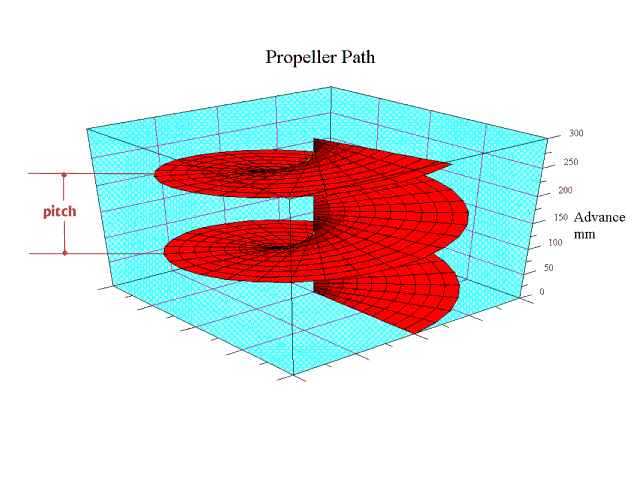 Back to
Back to Output
Propeller Motion
A propeller on a conventional aircraft (but not a helicopter) in flight can be viewed in an approximate way as a constant speed propeller rotation rate plus a constant speed forward motion in the direction of the propeller shaft. Any point on the propeller will trace out a helix (some people call this a spiral). A straight line running from prop tip to prop tip through the prop shaft will trace out what is technically known as a helicoid. An example of this shape is provided in the figure below.

The advance of the propeller each revolution is the pitch of the helix. Because this pitch is different form the pitch of the propeller at any blade station, I have chosen to call it the "flight helix pitch". As it is shown in the figure, the flight helix pitch is the same for any blade radius.
If, for example the engine is running at 18000 RPM the revolutions per second are 300 Hz. If the aircraft is flying at 90 mi/hr convert this to inches per second as:
90 * 88 * 12/ 60 = 1584 in/sec
The flight helix pitch is 1584 in/sec divided by 300revs/sec or 5.28 in.
These relations are listed for the two most favored "modeler units". Input engine speed in thousands of RPM. In the example above the engine speed is entered as 18.0. Enter aircraft speed in mi/hr to get pitch in inches. Enter speed in km/hr to get pitch in mm.
pitch = K * speed / thousand RPM
K (inches) = 1.056 (exact)
K ( mm ) = 16.667 (rounded to 5 significant digits)
Based on Bill Lee's estimate for competitive performance (i.e. competitive anywhere) of four control line racing classes, plus some information from Australia and Whittier Narrows, CA, the table below provides an estimate of flight helix pitch. The last entry, Bill Stewart's electric "B" speed record holder, lists the average RPM. The electric motor looses speed throughout the run. The range of engine speed for the electric model is 18,500 at the start to around 17,200 at the end.
In racing events the true speed is higher than listed here because the line length is used. The distance of the handle from the center of rotation is usually close to one foot which adds to the effective line length. The actual flight helix pitch will be a few percent larger than computed here because of this factor.
| Class | RPM thousands/min |
Time/Laps sec |
Speed mi/hr |
Helix Pitch inches |
| Scale Racing | 28-30 | 14.5 / 8 | 124 | 4.36-4.67 |
| TQR | 16-17 | 17.5 / 7 | 103 | 6.80-7.72 |
| Bendix(Oz) | 22 | 16.4 / 7 | 110 | 5.28 |
| Mouse I Ordinary |
19 | 15 / 5 | 60 | 3.33 |
| Mouse I Texas |
22-23 | 12.5 / 5 | 72 | 3.46-3.61 |
| F2C | 24-25 | 18.0 / 10 | 124 | 5.46-5.68 |
| F2A(record) | 38 | 12.0 / 9 | 186 | 5.18 |
| Electric B(record) | 18 (avg) | 15.0 / 7 | 119.6 | 7.0 |
That's not all to the story. The flight helix pitch is related to the propeller pitch, but inflow plays a significant role in the airflow at the propeller face. This subject is treated in my web page. See Microaeronautics